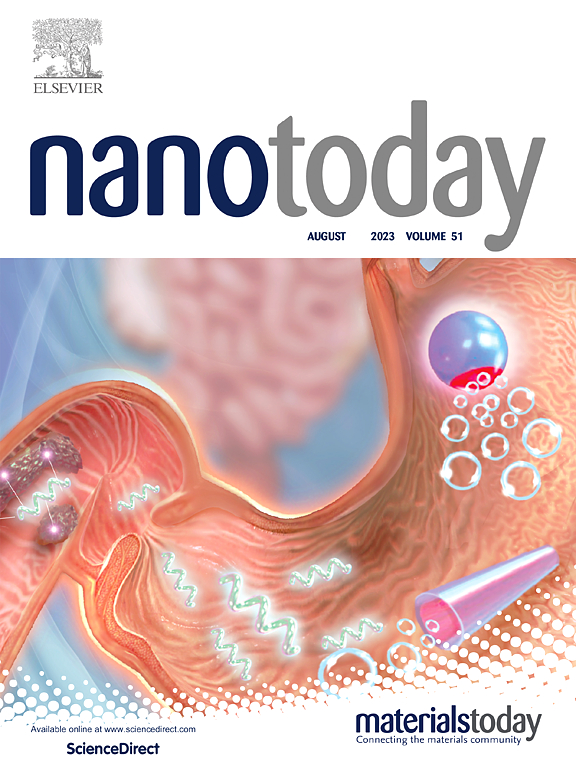具有双峰药理活性的甘草次酸-白蛋白纳米颗粒对急性肝损伤时间依赖性恢复的作用
IF 13.2
1区 材料科学
Q1 CHEMISTRY, MULTIDISCIPLINARY
引用次数: 0
摘要
急性肝损伤(ALI)是恶化为严重肝炎或致死性急性肝衰竭的关键起始事件。甘草酸已显示出治疗肝损伤和肝炎的临床有效性,但它需要代谢转化为甘草酸(GA)才能有效。然而,GA的应用受到溶解度差和快速清除的阻碍。考虑到GA对白蛋白的超高亲和力,报道了三种GA-人血清白蛋白纳米颗粒(GA@HSA NPs),其优化质量比为1:0.5、1:1和1:2。分子动力学模拟表明,GA主要占据HSA Sudlow位点I的结构域IIA。给药后,GA@HSA NPs的肝潴留显著增加,尤其是1:2 GA@HSA NPs。值得注意的是,GA@HSA NPs表现出双峰药理活性,包括对ALI的时间依赖性预防和治疗作用,这是通过降低细胞内一氧化氮(NO)、活性氧(ROS)和将促炎巨噬细胞恢复到正常巨噬细胞来实现的。在预防模式下,1:2 GA@HSA NPs甚至可以在确保安全性的情况下将ALI相关的肝功能指标恢复到正常水平,显示出强有力的治疗效果。这些发现为肝脏靶向治疗建立了一个范例,为ALI管理提供了机制见解和转化潜力。本文章由计算机程序翻译,如有差异,请以英文原文为准。
Glycyrrhetinic acid-albumin nanoparticles with bimodal pharmacological activities for time-dependent restoration of acute liver injury
Acute liver injury (ALI) represents a critical initiating event for deterioration into severe hepatitis or fatal acute liver failure. Glycyrrhizin acid has shown clinical effectiveness in managing liver injury and hepatitis, but it requires metabolic conversion to glycyrrhetinic acid (GA) to be effective. However, the application of GA is impeded by poor solubility and rapid clearance. Given the ultra-high albumin affinity of GA, three GA-human serum albumin nanoparticles (GA@HSA NPs) with optimized mass ratios (1:0.5, 1:1, and 1:2) were reported. Molecular dynamics simulations revealed that GA predominantly occupied structural domain IIA within Sudlow site I of HSA. Upon administration, the hepatic retention of GA@HSA NPs was significantly increased, especially for 1:2 GA@HSA NPs. Notably, GA@HSA NPs exhibited bimodal pharmacological activities, including time-dependent prophylactic and therapeutic effects on ALI, which were achieved by decreasing intracellular nitric oxide (NO), reactive oxygen species (ROS), and restoring pro-inflammatory macrophages to normal macrophages. In preventive mode, 1:2 GA@HSA NPs even restored liver function indicators involved in ALI to normal levels while ensuring safety, displaying potent therapeutic benefits. These findings established a paradigm for liver targeting therapy, offering mechanistic insights and translational potential for ALI management.
求助全文
通过发布文献求助,成功后即可免费获取论文全文。
去求助
来源期刊

Nano Today
工程技术-材料科学:综合
CiteScore
21.50
自引率
3.40%
发文量
305
审稿时长
40 days
期刊介绍:
Nano Today is a journal dedicated to publishing influential and innovative work in the field of nanoscience and technology. It covers a wide range of subject areas including biomaterials, materials chemistry, materials science, chemistry, bioengineering, biochemistry, genetics and molecular biology, engineering, and nanotechnology. The journal considers articles that inform readers about the latest research, breakthroughs, and topical issues in these fields. It provides comprehensive coverage through a mixture of peer-reviewed articles, research news, and information on key developments. Nano Today is abstracted and indexed in Science Citation Index, Ei Compendex, Embase, Scopus, and INSPEC.
 求助内容:
求助内容: 应助结果提醒方式:
应助结果提醒方式:


